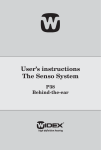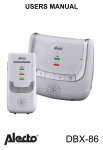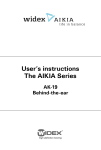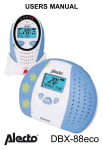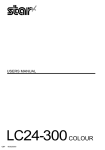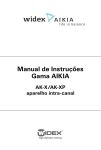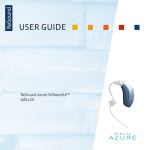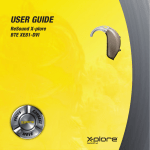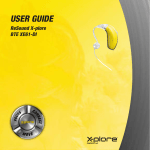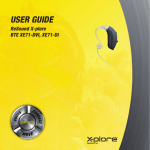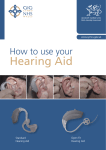Download User instructions AIKIA-m
Transcript
User instructions AIKIA-m Behind-the-ear General Hearing aids, accessories and batteries should not be disposed of with normal household waste. Please consult your national Widex distributor for advice on how to dispose of these items. Important The hearing aid, ear-set and accessories shown in these instructions may not look the same as the ones you have. We furthermore reserve the right to make any changes considered necessary. 2 3 General Contents Thank you… . . . . . . . . . . . . . . . . . . . . . . . . . . . . . . . . . . . . . . . . . . . 6 Ear-set solutions . . . . . . . . . . . . . . . . . . . . . . . . . . . . . . . . . . . . . . . 7 The hearing aid . . . . . . . . . . . . . . . . . . . . . . . . . . . . . . . . . . . . . . . . 8 Right/left identification . . . . . . . . . . . . . . . . . . . . . . . . . . . . . . . . 9 The battery . . . . . . . . . . . . . . . . . . . . . . . . . . . . . . . . . . . . . . . . . . . 10 Inserting the battery . . . . . . . . . . . . . . . . . . . . . . . . . . . . . . . 10 Removing the battery . . . . . . . . . . . . . . . . . . . . . . . . . . . . . . 12 Low battery indication . . . . . . . . . . . . . . . . . . . . . . . . . . . . . 13 Battery drawer without a nail grip . . . . . . . . . . . . . . . . . . 14 Turning the hearing aid on and off . . . . . . . . . . . . . . . . . . . . . 15 Possible start-up settings . . . . . . . . . . . . . . . . . . . . . . . . . . . . . . 16 Automatic volume adjustment . . . . . . . . . . . . . . . . . . . . . . . . 16 Listening programs . . . . . . . . . . . . . . . . . . . . . . . . . . . . . . . . . . . 17 Switching between the listening programs . . . . . . . . . 18 Remote control . . . . . . . . . . . . . . . . . . . . . . . . . . . . . . . . . . . . . . . 19 Using a telephone . . . . . . . . . . . . . . . . . . . . . . . . . . . . . . . . . . . . 19 Hearing aid with an earmould . . . . . . . . . . . . . . . . . . . . . . . . . . 20 Positioning the hearing aid and earmould . . . . . . . . . . . . . 21 Removing the hearing aid and earmould . . . . . . . . . . . . . . 22 Cleaning . . . . . . . . . . . . . . . . . . . . . . . . . . . . . . . . . . . . . . . . . . . . . . 23 The hearing aid . . . . . . . . . . . . . . . . . . . . . . . . . . . . . . . . . . . . 24 The microphone openings . . . . . . . . . . . . . . . . . . . . . . . . . 24 The earmould . . . . . . . . . . . . . . . . . . . . . . . . . . . . . . . . . . . . . . 25 Changing the tubing . . . . . . . . . . . . . . . . . . . . . . . . . . . . . . . . . . 26 Hearing aid with an instant ear-tip . . . . . . . . . . . . . . . . . . . . . 27 Right/left identification . . . . . . . . . . . . . . . . . . . . . . . . . . . . . . . 28 Positioning the hearing aid and instant ear‑tip . . . . . . . . . 29 Removing the hearing aid and instant ear‑tip . . . . . . . . . . 30 Cleaning . . . . . . . . . . . . . . . . . . . . . . . . . . . . . . . . . . . . . . . . . . . . . . 31 The hearing aid . . . . . . . . . . . . . . . . . . . . . . . . . . . . . . . . . . . . 32 The microphone openings . . . . . . . . . . . . . . . . . . . . . . . . . 32 The ear-set . . . . . . . . . . . . . . . . . . . . . . . . . . . . . . . . . . . . . . . . . 32 Changing the ear-set . . . . . . . . . . . . . . . . . . . . . . . . . . . . . . . . . . 35 Assembling a new ear-set . . . . . . . . . . . . . . . . . . . . . . . . . . . . . 36 Tubing and ear-tip size . . . . . . . . . . . . . . . . . . . . . . . . . . . . . . . . 37 The anchor . . . . . . . . . . . . . . . . . . . . . . . . . . . . . . . . . . . . . . . . . . . 38 Hearing aid with a custom ear-tip . . . . . . . . . . . . . . . . . . . . . . 42 Right/left identification . . . . . . . . . . . . . . . . . . . . . . . . . . . . . . . 43 Positioning the hearing aid and custom e ar‑tip . . . . . . . . 44 Removing the hearing aid and custom ear‑tip . . . . . . . . . 45 Cleaning . . . . . . . . . . . . . . . . . . . . . . . . . . . . . . . . . . . . . . . . . . . . . . 46 The hearing aid . . . . . . . . . . . . . . . . . . . . . . . . . . . . . . . . . . . . 47 The microphone openings . . . . . . . . . . . . . . . . . . . . . . . . . 47 The ear-set . . . . . . . . . . . . . . . . . . . . . . . . . . . . . . . . . . . . . . . . . 47 Changing the tubing . . . . . . . . . . . . . . . . . . . . . . . . . . . . . . . . . . 50 Assembling a new ear-set . . . . . . . . . . . . . . . . . . . . . . . . . . . . . 51 Tubing size . . . . . . . . . . . . . . . . . . . . . . . . . . . . . . . . . . . . . . . . . . . 52 In case of malfunction . . . . . . . . . . . . . . . . . . . . . . . . . . . . . . . . . 53 Caring for your hearing aid . . . . . . . . . . . . . . . . . . . . . . . . . . . . 55 Your hearing aid . . . . . . . . . . . . . . . . . . . . . . . . . . . . . . . . . . . . . . . 59 4 5 General Thank you… Ear-set solutions … for choosing a Widex hearing aid. Several ear-set solutions are available for your hearing aid. Below, your hearing care professional can tick the solution chosen for you. Your hearing aid is a sophisticated instrument that can be adjusted to your requirements in consultation with your hearing care professional. All illustrations in this booklet show a right-ear hearing aid. Unless otherwise stated, the same principles apply to the left ear. ❑❑ Earmould ❑❑ Instant ear-tip ❑❑ Custom ear-tip We hope you will be pleased with your new Widex hearing aid. Important Unless otherwise indicated, the information provided in this booklet applies to all three ear-set types. In addition to the general instructions, please be sure to read the sections that apply to your specific ear-set solution. 6 7 General The hearing aid Right/left identification The illustration below shows the hearing aid without the ear-set. If you wear hearing aids on both ears, the hearing aids can be provided with coloured marks (red mark = right and blue mark = left). 1. Microphone openings 2. Program button is available on some models. 3. On/off function 4. Nail grip The arrow shows the position of the identification mark. 1 4 3 2 8 9 General The battery We recommend zinc-air batteries. Use a size 10 for your hearing aid. To obtain replacement batteries, please consult your hearing care professional. It is important to take note of the expiry date and the recommendations regarding disposal of used batteries on the battery pack. Inserting the battery Before inserting a new battery in the hearing aid, remember to remove the adhesive tab. Once the tab has been removed, the battery will start functioning after a few seconds. Do not use batteries on which there is a sticky residue from the tab or other unwanted substance. 1. Use the nail grip to open the battery drawer. Do not press the battery drawer beyond the open position. 2. Place the battery in the drawer so that the plus (+) sign on the battery is facing in the direction indicated by the plus (+) sign printed on the round battery holder (see the long arrow). You can use the battery magnet provided to steer the battery into place. 1 + + 2 If the battery drawer does not close easily, the battery is incorrectly inserted. Always place the battery in the actual battery drawer as illustrated and not in the open space inside the hearing aid. 10 11 General Removing the battery 1. Open the battery drawer as previously described. Place the hearing aid on the cloth provided on a clean, plane surface and turn it as illustrated. 2. Supporting the drawer with your finger, use the battery magnet provided to push the battery out of the battery drawer from the minus side. Low battery indication If you hear four rapid beep-tones while wearing your hearing aid, it is an indication that the battery is nearly exhausted. Once the battery is totally exhausted, the hearing aid will be completely silent. Exactly how long the hearing aid will function after the low battery indication varies from one case to another. We recommend that you always have a spare battery with you. For adjustment of the beep-tone level or disabling of the function, please consult your hearing care professional. 1 2 12 Never leave an exhausted battery in the hearing aid. Exhausted batteries may leak, damaging the hearing aid. 13 General Battery drawer without a nail grip The hearing aid may be provided with a battery drawer without a nail grip, which means that you need a tool to open the battery drawer. This type of drawer can be a good choice if the hearing aid is worn by a child. A special tool for opening the drawer will be included with this drawer. The battery drawer is opened as illustrated. Turning the hearing aid on and off The battery drawer of your hearing aid also functions as the on/off switch. 1. Close the battery drawer to turn on the hearing aid. 2. Open the battery drawer to turn off the hearing aid. 1 2 Please remember to turn off the hearing aid when it is not in use. Remove the battery if the hearing aid will not be used for several days. 14 15 General Possible start-up settings Listening programs The hearing aid can be set to start up in two different ways: Your hearing aid may be provided with up to two listening programs intended for specific listening situations. • In the standard start-up setting the hearing aid minimises whistling while it is being placed on the ear. • The alternative is a setting in which the hearing aid whistles slightly while you place it on the ear. Together with your hearing care professional you can choose the start-up setting that best suits your needs. At the back of this booklet your hearing care professional can list the listening programs that are available in your hearing aid. If your needs change over time, the combination of listening programs can be altered. You can choose from the following programs: Master: Standard program Automatic volume adjustment The hearing aid volume is adjusted automatically in accordance with your sound environment. Acclimatisation: Has the same features as the Master program, but provides slightly less amplification. Music: For listening to music. TV: For listening to the TV. Important If the volume in your hearing aid is generally too loud or too weak, or if the reproduced sounds are distorted, or if you would like any further information, consult your hearing care professional. 16 17 General Switching between the listening programs If your hearing aid model is provided with a program button, you can switch between the listening programs by pressing this button. Beeptones will tell you which program you have chosen: Program 1: One short beep Program 2: Two short beeps Remote control Some hearing aid models may be provided with a remote control. These hearing aids have no program button. If your hearing aid has a remote control, please refer to the user’s instructions for the remote control. Using a telephone When using a telephone, we recommend that you hold the telephone against your head at an angle above your ear, rather than directly against the ear. If the sound is not optimal, try moving the telephone earpiece to a slightly different position. 18 19 Hearing aid with an earmould Hearing aid with an earmould Positioning the hearing aid and earmould The ear-set consists of the following parts: 1. Earhook 2. Tubing 3. Earmould 3a. Sound bore 3b. Vent 1. Insert the earmould in the ear canal while holding the lower part of the tubing. 2. It may help to pull the outer ear backwards and upwards with the opposite hand. 3. Place the hearing aid behind the ear, so that the hearing aid earhook rests comfortably on the ear, close to your head. 1 2 3a 3b 3 1 2 3 20 21 Hearing aid with an earmould Removing the hearing aid and earmould Cleaning 1. Remove the hearing aid from its position behind the ear. 2. Carefully pull the earmould out of the ear canal, while holding the lower part of the tubing. The following cleaning accessories are available for the hearing aid and ear-set: 1 2 1. Soft cloth 2. Wax removing tool 1 2 If it is difficult, you can try to move the earmould carefully from side to side while pulling it out. It may also help to pull the outer ear backwards and upwards with the opposite hand. Contact your hearing care professional if you need additional supplies of cleaning accessories. 22 23 Hearing aid with an earmould The hearing aid Clean the hearing aid with the soft cloth after use. Never use water or cleaning solutions to clean the hearing aid. The microphone openings Clean the microphone openings by passing the wax removing tool straight through the openings. The earmould Make sure that your earmould is clean and free of earwax and moisture. Never use alcohol or other cleaning solutions to clean the earmould. Cleaning the earmould: 1. Disconnect the earmould from the tubing. 2. Clean the vent with the wax removing tool. 3. Clean the sound bore with the wax removing tool. 1 2 If you feel resistance, withdraw the tool and try again. Use only the wax removing tool provided. When the hearing aid is not in use, the battery drawer should be left open, so as to ventilate the hearing aid and allow it to dry. 24 3 25 Hearing aid with an instant ear-tip 4. At least once a week, disconnect the earmould from the tubing and rinse the earmould thoroughly in lukewarm water. Allow it to dry overnight. 5. If there is still moisture in the earmould, use a blower or similar to blow it dry before attaching the earmould to the tubing. 4 5 Hearing aid with an instant ear-tip The ear-set consists of the following parts: 1. Tubing with 1a. hook 1b. anchor 2. Instant ear-tip Changing the tubing If your ear-set tubing becomes slack, stiff, yellow or cracked, replace the tubing. For further supplies of tubing or if the earmould no longer fits your ear, contact your hearing care professional. 26 27 Hearing aid with an instant ear-tip Right/left identification The ear-set tubing is available in different lengths for the right and left ear, respectively. The individual size is printed on the tubing. Red print indicates that it is for the right ear, and blue print that it is for the left ear. Positioning the hearing aid and instant ear‑tip 1. Place the hearing aid behind the ear, so that the tubing rests comfortably on the ear, close to your head. 2. Insert the ear-tip in the ear canal while holding the lower part of the tubing. 1 2 Make sure that the anchor is positioned correctly, securing the position of the ear-set. Check at regular intervals that the hearing aid and earset are positioned correctly. Important We do not recommend wearing the hearing aid without the anchor for the instant ear-tip solution. If the hearing aid is not secured by the anchor, it can fall off your ear and be lost. 28 29 Hearing aid with an instant ear-tip Removing the hearing aid and instant ear‑tip Cleaning 1. Remove the hearing aid from its position behind the ear. 2. Carefully pull the ear-tip out of the ear canal, while holding the lower part of the tubing. The following cleaning accessories are available for the hearing aid and ear-set. 1. Soft cloth 2. Wax removing tool 3. Cleaning thread 3 1 2 1 2 Contact your hearing care professional if you need additional supplies of cleaning accessories. 30 31 Hearing aid with an instant ear-tip The hearing aid Clean the hearing aid with the soft cloth after use. Never use water or cleaning solutions to clean the hearing aid. The microphone openings Clean the microphone openings by passing the wax removing tool straight through the openings. If you feel resistance, withdraw the tool and try again. Use only the wax removing tool provided. When the hearing aid is not in use, the battery drawer should be left open, so as to ventilate the hearing aid and allow it to dry. Wipe the ear-set with the soft cloth at regular intervals. Never use alcohol or other cleaning solutions to clean the ear-set. Cleaning a blocked tubing: 1. Grip the hearing aid between your thumb and index finger. With your other hand grip the tubing and pull straight apart as indicated by the arrow. Alternatively, a small tool is available for removing the tubing. Contact your hearing care professional if you want more information. 2. Pull the ear-tip off the tubing. 3. Pass the cleaning thread through the tubing. Pull the thread out at the other end. 1 2 3 The ear-set Make sure that the ear-set is clean and free of earwax, moisture or the like. Otherwise the ear-tip may come off. 32 33 Hearing aid with an instant ear-tip If necessary, the ear-tip can be rinsed: Pull the ear-tip off the tubing. Rinse the ear-tip thoroughly in lukewarm water. Allow it to dry overnight. Changing the ear-set The ear-set should be changed on a regular basis. The life of the ear-set is individual and depends on a number of factors, such as how much the hearing aid is used and the type of earwax. If one of the ear-set elements becomes slack, stiff, yellow or cracked, replace the ear-set. For further supplies of ear-sets or if the ear-tip size no longer fits your ear, contact your hearing care professional. 34 35 Hearing aid with an instant ear-tip Assembling a new ear-set Push the ear-tip onto the tubing. It is very important that the ear-tip is firmly secured. Tubing and ear-tip size The ear-set must fit your ear exactly. It is important to choose the correct tubing length and ear-tip size in order to ensure a good and comfortable fit. At the back of this booklet your hearing care professional can write down the sizes selected for you. Click the ear-set onto the top of the hearing aid as illustrated. 36 37 Hearing aid with an instant ear-tip The anchor The anchor is supplied separately from the rest of the ear-set and can be used in different ways. First it is shown how the anchor can be used without prior trimming: 1a. Pull the pointed end of the anchor through the upper hole on the side of the tubing until the anchor is stopped by the grip at the end. The angled grip should be pointing towards the hearing aid. 1b. Your ear-set is now ready for use and is placed so that it rests comfortably in your ear. The anchor can also be trimmed to fit your ear. There are several ways of doing this. Two such examples are shown here: Example 1 1a. Pull the pointed end of the anchor through the upper hole on the side of the tubing until the anchor is stopped by the grip at the end. The angled grip should be pointing towards the hearing aid. 1b. Guide the pointed end of the anchor through the lower hole to form a loop. 1c. When the loop is the correct size, cut off any excess with scissors or similar. 1a 1a 1b 1b 1c 38 39 Hearing aid with an instant ear-tip Example 2 2a. Pull the pointed end of the anchor through the upper hole on the side of the tubing until the anchor is stopped by the grip at the end. The angled grip should be pointing towards the hearing aid. 2b. Loop the anchor in the direction indicated by the dotted line and arrows. 2c. Guide the anchor through the lower hole on the side of the tubing as illustrated to form a loop. 2d. When the loop is the correct size, turn the ear-set around and cut off any excess with scissors or similar. 2a General information 3. Make sure that the end of the anchor loop is flush with the small hole and there are no sharp edges. Use the tip of your finger to check for sharp edges. 3 If part of the anchor sticks out through the hole, creating an uneven surface, this may cause irritation of the ear. 2b 2c 40 2d 41 Hearing aid with a custom ear-tip Hearing aid with a custom ear-tip The ear-set consists of the following parts: 1. Tubing with 1a. hook 2. Custom ear-tip with 2a. extraction cord 2b. optional vent Right/left identification The ear-set tubing is available in different lengths for the right and left ear, respectively. The individual size is printed on the tubing. Red print indicates that it is for the right ear, and blue print that it is for the left ear. The custom ear-tip has ”Widex” printed on it. Red print indicates that the ear-tip is for the right ear, and blue print that it is for the left ear. 2. 42 43 Hearing aid with a custom ear-tip Positioning the hearing aid and custom ear‑tip Removing the hearing aid and custom ear‑tip 1. Insert the custom ear-tip in the ear canal while holding the lower part of the tubing. 2. It may help to pull the outer ear backwards and upwards with the opposite hand. 3. Place the hearing aid behind the ear, so that the tubing rests comfortably on the ear, close to your head. 1. Remove the hearing aid from its position behind the ear. 2. Take hold of the extraction cord and carefully pull the custom ear-tip out of the ear canal. 1 1 2 2 3 Important Do not pull the tubing to remove your hearing aid. Use the extraction cord. 44 45 Hearing aid with a custom ear-tip Cleaning The following cleaning accessories are available for the hearing aid and ear-set. 1. Soft cloth 2. Wax removing tool 3. Cleaning thread The hearing aid Clean the hearing aid with the soft cloth after use. Never use water or cleaning solutions to clean the hearing aid. The microphone openings Clean the microphone openings by passing the wax removing tool straight through the openings. 3 1 2 Contact your hearing care professional if you need additional supplies of cleaning accessories. If you feel resistance, withdraw the tool and try again. Use only the wax removing tool provided. When the hearing aid is not in use, the battery drawer should be left open, so as to ventilate the hearing aid and allow it to dry. The ear-set Make sure that your ear-set is clean and free of earwax, moisture or the like. Wipe the ear-set with the soft cloth at regular intervals. Never use alcohol or other cleaning solutions to clean the ear-set. 46 47 Hearing aid with a custom ear-tip Cleaning a blocked tubing: 1. Grip the hearing aid between your thumb and index finger. With your other hand grip the tubing and pull straight apart as indicated by the arrow. Alternatively, a small tool is available for removing the tubing. Contact your hearing care professional if you want more information. 2. Carefully pull the custom ear-tip off the tubing, wriggling the tip of the tubing gently. 3. Pass the cleaning thread through the tubing. Pull the thread out at the other end. 1 If necessary, the custom ear-tip can be rinsed: Pull the ear-tip off the tubing, as described. Rinse the ear-tip thoroughly in lukewarm water. Allow it to dry overnight. 2 3 48 49 Hearing aid with a custom ear-tip Changing the tubing Assembling a new ear-set The tubing should be changed on a regular basis. The life of the tubing is individual and depends on a number of factors, such as how much the hearing aid is used. 1. Hold the custom ear-tip between two fingers, with the extraction cord downwards. Hold the tubing with the other hand as illustrated. Gently press the tubing into place in the custom ear-tip. 2. Use your fingernail to press the tubing in as far as it will go so that it is securely fastened. 3. Click the ear-set onto the top of the hearing aid as illustrated. If your ear-set tubing becomes slack, stiff, yellow or cracked, replace the tubing. For further supplies of tubing or if the custom ear-tip no longer fits your ear, contact your hearing care professional. 1 2 3 50 51 General In case of malfunction Tubing size The ear-set must fit your ear exactly. It is important to choose the correct tubing length in order to ensure a good and comfortable fit. At the back of this booklet your hearing care professional can write down the tubing size selected for you. Problem Potential cause Solution The hearing aid is dead The hearing aid is not turned on Make sure the battery drawer is closed The battery is dead Insert a new battery in or does not work the battery drawer The sound outlet of the earmould/ ear-tip is blocked The hearing The battery is nearaid volume is ly exhausted not powerful The sound outlet enough of the earmould/ ear-tip is blocked Earmould: Clean the blocked sound bore (see page 25) Instant ear-tip: Replace or clean the ear-tip (see page 34) Custom ear-tip: Clean the ear-tip (see page 49) Insert a new battery in the battery drawer Earmould: Clean the blocked sound bore (see page 25) Instant ear-tip: Replace or clean the ear-tip (see page 34) Custom ear-tip: Clean the ear-tip (see page 49) Your ear is blocked Contact your ENT by earwax doctor/physician Your hearing may have changed 52 53 Contact your hearing care professional General Problem Potential cause Solution The hearing Your ear is blocked Contact your ENT aid whistles by earwax doctor/physician continuously The tubing is yelReplace the tubing low, stiff or broken The earmould/ ear-tip is not correctly placed in your ear canal Take the earmould/ ear-tip out and reinsert it The earmould/ ear-tip fit is too loose Contact your hearing care professional Earmould: The tubing often comes off the earmould or hearing aid hook Replace the tubing Earmould: The hook is cracked Contact your hearing care professional 54 Caring for your hearing aid The hearing aid is a valuable object and should be treated with care. Here are some things you can do to prolong the life of your hearing aid: • Turn off your hearing aid when it is not in use. Remove the battery if the hearing aid will not be used for several days. • When the hearing aid is not in use, keep it in its case in a cool, dry location out of reach of children and pets. • Do not expose the hearing aid to extreme temperatures or high humidity. • In environments with high humidity, a Widex drying kit may be used daily to reduce the amount of moisture inside the hearing aid. See the instructions enclosed with the Widex drying kit. • Do not wear your hearing aid while in the shower or swimming, or when using a hair dryer, perfume or other sprays. 55 General • Never try to open or repair the hearing aid yourself. • Do not wear your hearing aid during X-rays, MR scans, CT scans, short-wave diathermy, or similar radiation treatments and never place your hearing aid in a microwave oven. These are some of the types of radiation that can damage your hearing aid. Radiation from, for example, room surveillance equipment, burglar alarms and mobile phones is weaker and will not damage your hearing aid but may cause interference. • Widex hearing aids are not certified for use in mines or other areas with explosive gases. • To maintain the proper shape of the ear-set, be careful not to twist or squeeze it out of shape when your hearing aid is placed in the case. Good advice and warnings Hearing aids and batteries can be dangerous if swallowed or used improperly. Swallowing or improper use can result in severe injury, or even fatalities. In case of ingestion, contact a physician immediately. • Keep hearing aids and their parts, accessories and batteries out of reach of children and anyone else who might swallow such items or otherwise cause injury to themselves. Do not change batteries in front of them and do not let them see where you keep your battery supply. Discard used batteries carefully. • Batteries are very small and can easily be mistaken for pills or the like. Never put a battery or hearing aid in your mouth for any reason as you may risk swallowing it. • Never allow others to wear your hearing aid, as this could cause permanent damage to their hearing. • The hearing aid will not restore normal hearing but can help you to make the best possible use of your remaining hearing ability. However, you should be aware that it takes time to get used to a new hearing aid and new sounds. CAUTION Risk of explosion if battery is replaced by an incorrect type or recharged. Dispose of used batteries according to the instructions. 56 57 General • The use of hearing aids increases the risk of accumulation of earwax. Contact your physician/ENT doctor if you suspect that a plug of earwax has accumulated in your ear. Earwax may not only reduce your own hearing but also the effect of the hearing aid considerably. It is a good idea to ask your physician to clean your ears a couple of times a year. • The hearing aid is made of modern non-allergenic materials. Nonetheless, in rare cases skin irritation may occur. If you notice skin irritation in or around your ear or ear canal, contact your hearing care professional. • Be aware that the use of any type of hearing aid may involve a slightly increased risk of infection in the ear canal. An infection can arise as a result of inadequate ventilation of the ear. We therefore recommend that you remove the hearing aid and ear-set from your ear at night to allow the ear canal to be ventilated. Make sure that you clean and inspect your hearing aid and ear-set as required. If an infection occurs, you should seek medical attention and contact your hearing care professional for advice on how to disinfect the various hearing aid parts. Do not under any circumstances use alcohol, chlorine or similar substances. 58 Your hearing aid (To be filled out by the hearing care professional) Date:______________________________ Battery size:________________________ Ear-set: ❑❑ Earmould ❑❑ Instant ear-tip ❑❑ Custom ear-tip Ear-tip-size: Left_ _______ Right________ Tubing size: Left_ _______ Right________ Listening programs Chosen program position Master Acclimatisation Music TV 59 ¡9 514 0127 001|¤ ¡#01v¤ Printed by HTO / 05-10 9 514 0127 001 #01
































